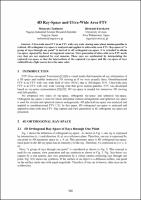Chapter 4D Ray-Space and Ultra-Wide Area FTV
| dc.contributor.author | Tanimoto, Masayuki | |
| dc.contributor.author | Kurokawa, Hirokuni | |
| dc.date.accessioned | 2022-06-01T12:08:11Z | |
| dc.date.available | 2022-06-01T12:08:11Z | |
| dc.date.issued | 2018 | |
| dc.identifier | ONIX_20220601_9788864537078_79 | |
| dc.identifier.issn | 2704-5846 | |
| dc.identifier.uri | https://library.oapen.org/handle/20.500.12657/55896 | |
| dc.description.abstract | Ultra-wide area FTV is an FTV with very wide viewing zone where motion parallax is realized. 4D orthogonal ray-space is analyzed and applied to ultra-wide area FTV. Ray-space of “a group of rays through one point” is derived in 4D orthogonal ray-space. It is extended to obtain ray-space captured by linear arrangement cameras. View generation of ultra-wide area FTV needs rays that are not captured by real cameras. These rays are synthesized by interpolating the captured ray-space so that the intersections of the captured ray-space and the ray-space of rays emitted from a light source have the same color. | |
| dc.language | English | |
| dc.relation.ispartofseries | Proceedings e report | |
| dc.subject.other | 4D Ray-Space | |
| dc.subject.other | FTV | |
| dc.subject.other | Free-Viewpoint Television | |
| dc.title | Chapter 4D Ray-Space and Ultra-Wide Area FTV | |
| dc.type | chapter | |
| oapen.identifier.doi | 10.36253/978-88-6453-707-8.24 | |
| oapen.relation.isPublishedBy | bf65d21a-78e5-4ba2-983a-dbfa90962870 | |
| oapen.relation.isbn | 9788864537078 | |
| oapen.series.number | 118 | |
| oapen.pages | 8 | |
| oapen.place.publication | Florence |

